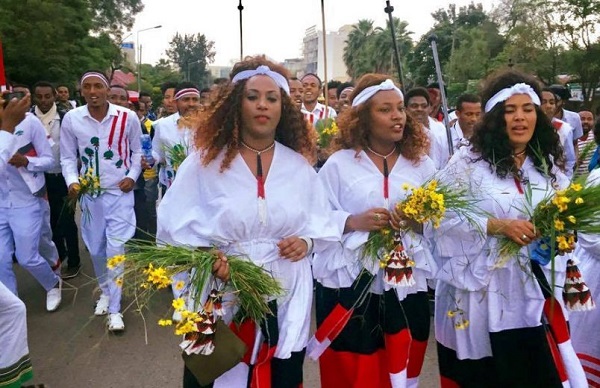
BY STAFF REPORTER
“Kiremet Ethiopia’s rainy season is a gloomy one. Hence darkness eclipses the vibe. Dusk is suitable to wild animals not for human beings. When darkness fights shy it cedes place to brightness. When glare takes the upper hand, room for anxiety is slim. A wide-open door for happiness is felt everywhere. All this is encapsulated in the expression Meskerem Teba (September) has set in,” according to anthropologists.
Irreechaa is one of the salient holidays that is accorded a special attention among the Geda system, which is one of Ethiopia’s UNESCO registered heritages. There is also a belief Irreechaa is usherer of all holidays. This holiday that holds a special place in the Oromo culture is colorfully marked every year. There is also a belief that Irreechaa is a time darkness and light, nightfall and daybreak, black sky and a sunny one exchange places. The society passes all through these as the trend is a natural phase considered a super handiwork of the Almighty.
The fact Irreechaa is marked (begins) at the first chapter of the year when the heavy-rain feeding and overflowing rivers ebb out, the chilling cold yields hand to warmth. It is also a time crops proffer seeds. This is sign enough that Irreechaa is entwined with the weather calendar or nature. It is a cultural system for praising God the Almighty. Accordingly, the Oromo People express gratitude to the Almighty who brought forth everything. Irreechaa’s principle is rooted in the belief “in the presence of peace, nature lets go what it have to mankind, who on his turn must pay back what he owes to the Almighty.” During this holiday, the strong bond between human being and nature finds an expression.
“Irreechaa embodies reciprocity—expressing gratitude to all forms of kindness extended regardless of the magnitude of the gesture. It preaches this life principle. Giving a handful of lash grass with a single penny by itself has its own value. A lash grass is a symbolism of fertility and fructification,” anthropologists note.
Celebrants abundantly bless the Almighty for covering the landscape with a green mantle sporting flowers as well as for allowing the harvest in the process of ripping. Also praises are extended to God for the multiplying over of domestic animals that are seen running berserk. It is a big event when men, the handiwork of the Almighty, supplicate with a pure heart.
Any participant of Irreechaa has to bury the hatchet with God, nature, himself and mankind in general. He has to cleanse himself before participating in the event. Even someone who might have inflicted harm on nature has to present himself taking due punitive measures.
The Irreechaa ceremony entails tradition and philosophy. It lauds Almighty’s omnipotence and miracle. It sheds light on the perpetuity of generation. It is not few experts in the field that likens the circle of life –procreation and death and the growing of a seed after falling on soil— with God’s omniscience. This process is one that won Waka’s (God’s) go ahead. It is a concept that rams home the continuation of life after death.
Celebrants enumerate all the blessings they received in their life and thank the Almighty God. The bliss, serenity, health, love, respect, sustainability, hope are but those top on the list. They thank God that transitioned them from a bleak to a bright season.
Carrying lash grasses and flowers going to rivers to praise the Almighty is a common practice in Irreechaa. Praising God with his handiwork is a tradition bequeathed from the past. As riversides, at this precise moment in time, display greenery they prove favorable places to present laudations to the Almighty. Feasting their eyes on the scenery, celebrants at the same time offer praises to the creator of the universe.
Irreechaa is celebrated in the two consecutive Saturday and Sunday following Meskel. As Irreechaa marks a season of brightness and optimism singing and dancing is allowed at such occasions.
The Ethiopian Herald October 2/2022





